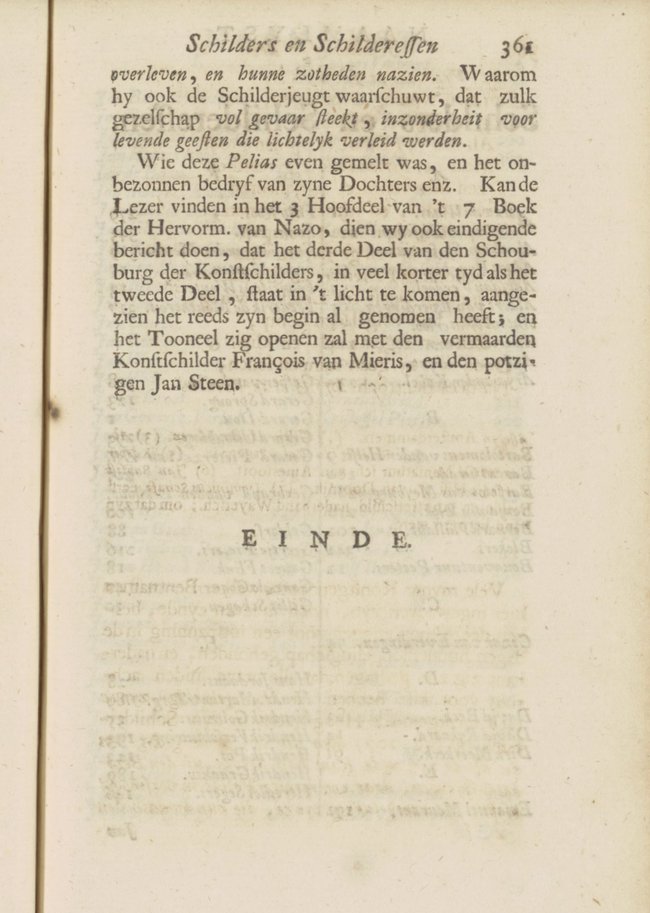Volume 2, page 350-361
Page 350
And the (14) Eagle’s gnashing beak,
Wake Rester from his sleep;
Which still often the Sweet Sound
Of the Bagpipe and the Flute
Tests for (15) Orpheus’ golden strings;
Which had the animals gather
While most painting (16) Youth;
All night in Enjoyment
Sat emptying mugs,
Which (17) Sensuality while emptying
Easily as tasty in that place
As in beautiful land of plenty)
(18) Porridge Mountain, (19) Diligence and Smooth Talker.
Scrubber, who made it fair,
Sat with (20) Guzzler, Looser,
And Profligate, pair by pair;
Where they, sleepy from the mugs
Fill the (21) Corpus without money.
(22) Courage and Alarm Clock toasted them.
(23) Rattle also spoke of going
To take a walk outside;
Unaware that it would cause
Such a terrible (24)Tempest:
--------
He also had a son [= nephew: Martin Mytens I] who was a commendable master who lives in Stockholm in Sweden.
(13) Dionys Godijn. Figure painter from The Hague. (14) Mattheus Terwesten. The Hague history and soldier painter. (15) Philips van der Does. (16) François Monnaville, history painter from Antwerp. (17) Paul marine and moonshine landschape painter from Antwerp. (18) Gilles du Mont. (19) Pieter Claessens II, history painter from Antwerp. (20) Dirk Visscher. (21) Artus Quellinus I, who made the marble statues on the Amsterdam city hall. (22) Hans Martijn, German history painter, Disciple of Johann Carl Loth and Cavalier Daniel Seiter. (23) David de Coninck, bird, flower and other still life painter from Antwerp. (24) Pieter Mulier II from Haarlem.
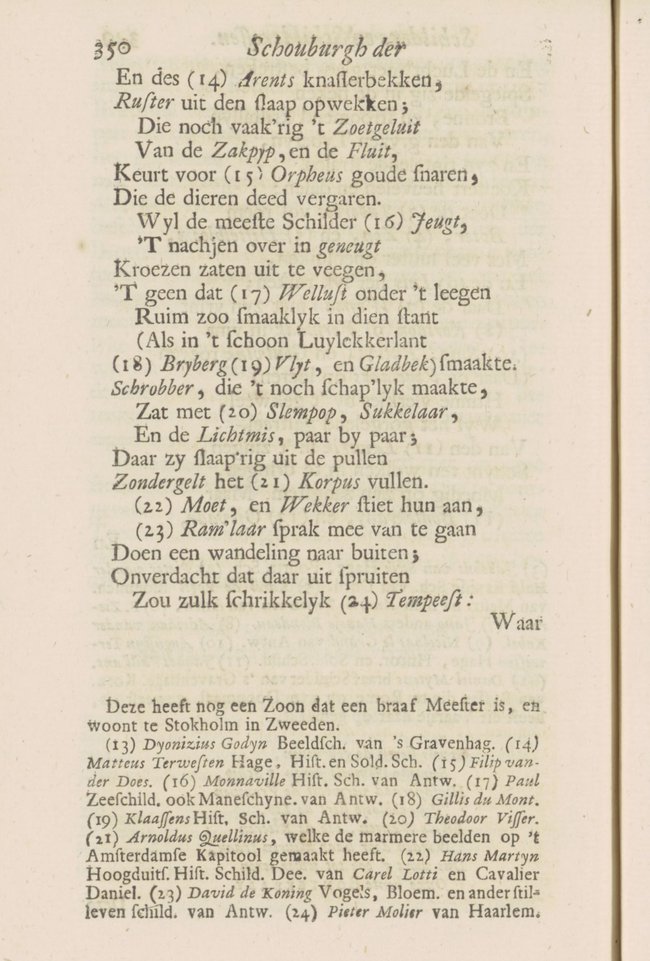
Page 351
For which Fighting Cock
By his burning Fighting Spirit
Was most responsible. He laid his hands
First on (25) Silence, who crushed
By that uproar, was opposed.
(26) Pirate to all appearances also angered,
Wishes to follow in the combat trail with (27) Mars
(28) Loose Mess attacks (29) Banner
Profligate dares hit the (30) Knight.
(31) Jason with the blows of his fists.
They spare neither small nor large.
(32) Mithridates weighed way too little
Against (33) Mars, who with his bolt.
And his terrible glances,
Would frighten even (34) Charon
(35) Cephalus and the African,
(36) Devout and (37) Archimedes stand
(For who will lower the flag)
Looking at the game attentively.
(38) Gladiator creates violence
Braces himself in the wrestling ring
Against (39) Rhine Count and (40) Janissary,
Though he held his ground like a Swiss,
Where the alert (41) Batavian,
--------
(25) Herman van Lin, horse painter. (26) Pieter de Zeelander, sea and ship painter. (27) Flower painter from Sweden. Disciple of Distelbloem. A curser who had lost an eye by often fighting. (28) Adriaen Honich, landscape painter from Dordrecht. (29) Pieter van Bloemen, battle painter from Antwerp. (30) Gommarus Wouters, history painter from Antwerp. (31) Jacob Toorenvliet of Leiden, society painter. (32) Nicolaas van Haringen. (33) -- see 27. (34) Jan van der Hooge. (35) Norbert van Bloemen, society painter from Antwerp. (36) Thomas Mathisen from Antwerp. (37) Abraham Genoels II, landscape painter from Antwerp. (38) Jacobus de Baen, portrait painter from The Hague. (39) Abraham Brueghel, flower painter from Antwerp. (40) Pieter Hofman, battle painter of Antwerp, was in Turkey for a long time with Zandruiter, landscape painter. (41) Samuel van Hoogstraten
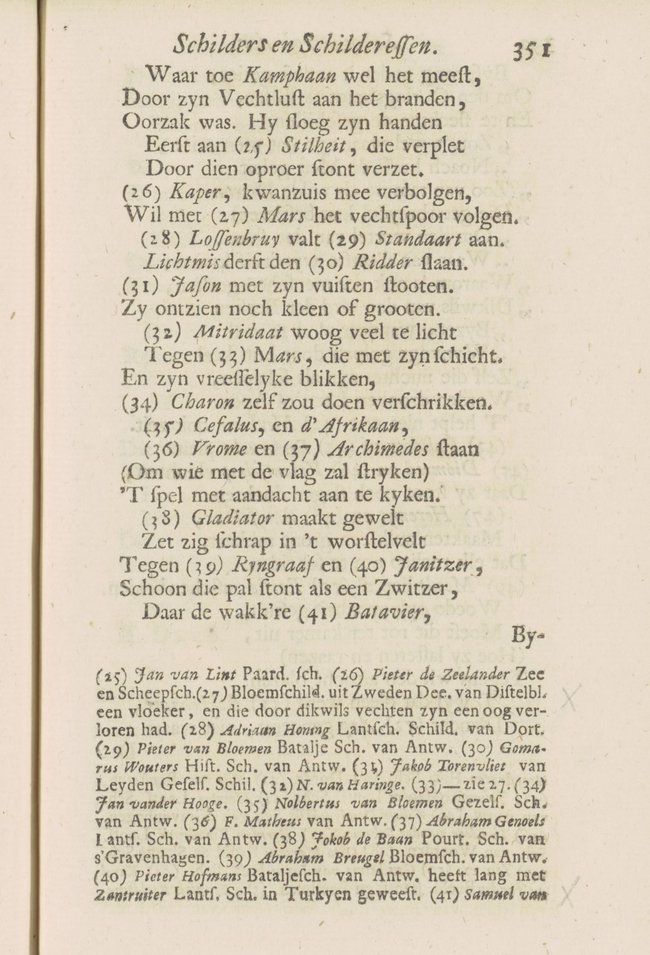
Page 352
Joined in with violent oaths:
To quench the fire of war,
And settle the differences.
"It would be true if one said:
“Noah has led the most
"(Of both tame and wild animals
“which cannot be led by any bridle)
“Around the root of the trunk,
“From which the first wine grape came;
“Why also human spirits
“Often of the nature of beasts
“Partake when they all to much
“Gulp wine liquid down their throats:
“Even those who are sober as sheep
“Become drunken lion or monkeys.
It helps not what (42) Mercury may say.
(43) Polydorus or (44) Fruit of honour plead.
(45) Diomedes and (46) Friendship flee,
Where they fear neither thrusts nor blows.
(47) Hermit and (48) Sniffer
Made such a great outcry,
That all approached to separate.
(49) Courage was the (50) First to come between them.
Mounting rage stemmed,
This mess had to be thrown out,
(How they slander and roar)
Blow the retreat against their will,
While one was called 51) Goat Beard
The other named 52) Monkey, not worthy
--------
history painter of Dordrecht. (42) Philipp Peter Roos Figure painter. (43) Johannes Glauber Landscape painter. (44) Jan de Momper, landscape painter from Antwerp. (45) Willem Doudijns, history painter from The Hague. (46) Theodoor van der Schuer. (47) Herman van Swanevelt, landscape painter from Woerden. 48) Otto Marseus van Schrieck, herb and snake painter. (49) See 22. (50) Willem van Ingen, history painter. (51) Karel du Jardin, figure, landscape and animal painter (52) Frans Beeldemaker
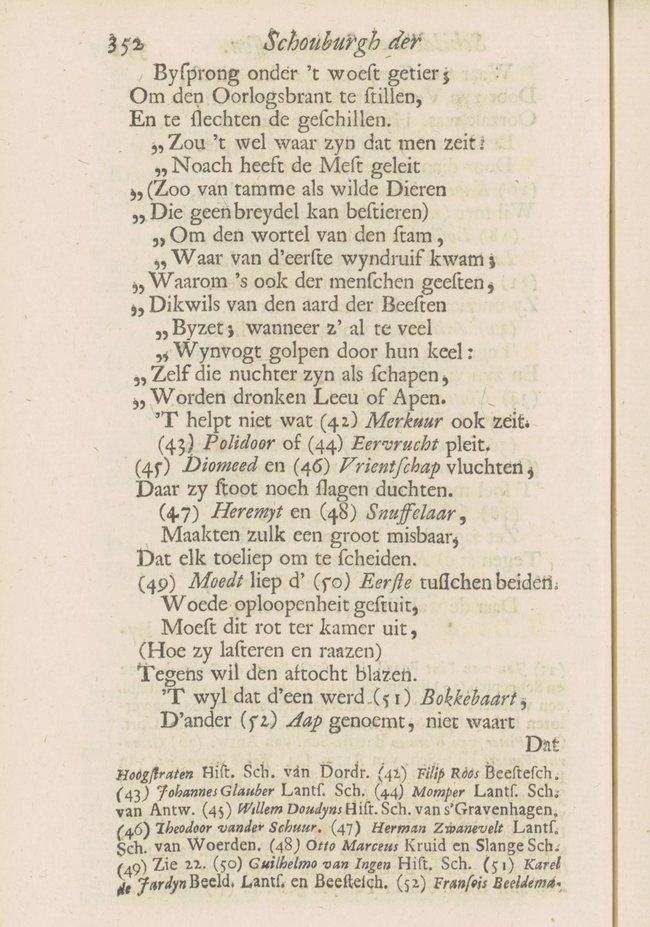
Page 353
To ever join the company
And have to be ashamed of themselves.
With this the aftermath came
The small group of the Bent. (53) Askaan
Was laid out like Bacchus,
His lion’s skin a blanket
Rough, encircled with a belt.
Thus he preened jauntily
Under the shadow and the foliage
Of his wreath, beyond care:
As the provider of the wine
Which cheers up man. His
Sceptre was a (54) Porridge Spoon
Which also served as a clapper
When he on his (55) Kettle Drum
Made such a loud field drumming
That even (56) Echo, well hidden,
Resounds from hidden burrows.
He sat on a wagon throne,
Next to him the beautiful (57) Adonis
Who played for Ariadne
To depict the fable.
Everyone sprang around the field coach
Like a (58) Satyr fleet of foot
--------
The Hague. (53) Domenicus van Wijnen, history and society painter. (54) Hans Jordaens IV. Potlepel. History painter from Delft. (55) Jan van Bunnick, landscape painter. (56) Claude Albert Sevin, history and portrait painter from Brussels. (57) Cornelis de Bruyn, whose travel description has come out in print. (58) Cornelis van Ryssen, artful goldsmith, stone setter and witty epigrammatist, who was a member of the Roman Bent and often associated with them in 1667 and 1668. He also made a list of the bentvogels then present, which we have taken over and used here. He was exceptional comical, but not in the least sharp by nature, which is why they gave him that Bent name for good reason.
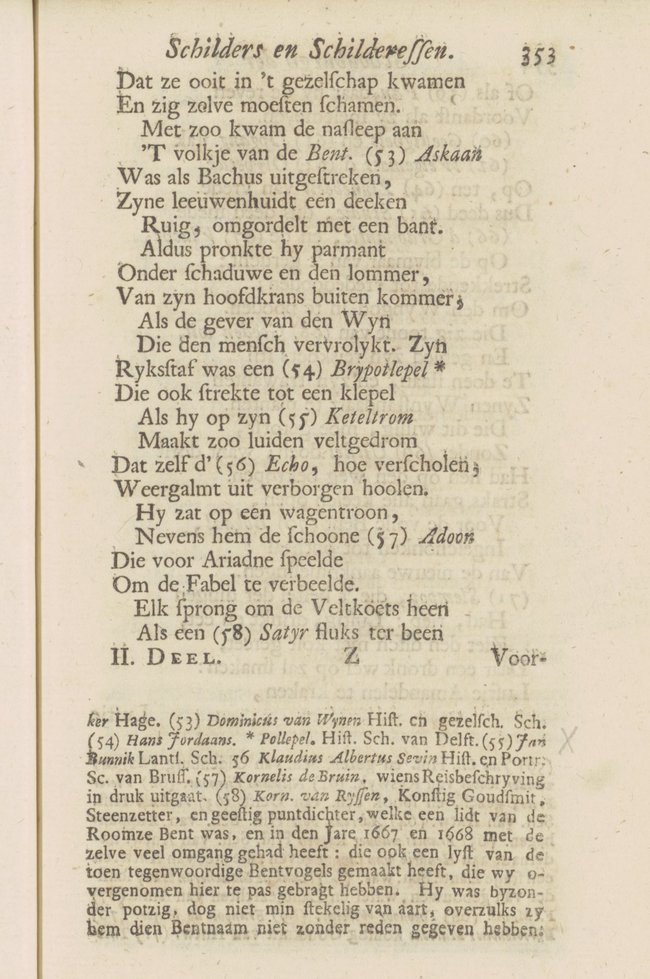
Page 354
Or like (59) Pan, where he dances
Ahead of the rows as they frolic.
(60) Wittiness and (61) Sunrise pinned
On (62) Good Natured the (63) Olive branch
As (64) Emblem of Peace.
Thus did (65) Study, also joined in
The (66) Ordinance and (67) Flight
On the cheerful content of the rumour:
Extending to emissaries of peace;
To invite the wine god
Who shows himself of (68) Goodwill,
And orders that his travel coach
Stand still, and his cronies
Plant his wine standard.
Who do this willingly, tired of carrying,
Without (69) Delay, for thirst
Had crept up on them on the way.
At once all throats open up,
For the complete bent, (70) Goblet
Filled to welcome
Of the new arrivals.
(71) Guzzler, who got to order things
Called out: Be merry, drink and eat,
See the dish with food prepared,
Which will taste good with a drink:
Do you like to crack almonds,
--------
(59) Johann Liss II, history and society painter from Oldenburg. (60) Adriaen van der Kabel from Rijswijk. (61) Nicolaes Piemont. (62) Pieter Fris, society and ghost painter from Delft. (63) Rombout Verhulst, history painter from Antwerp. (64) Adriaen Foly, history painter from Copenhagen. (65) Francis van der Kappen, history painter from Antwerp, later given to Hendrik Frans van Lint, who was also from Antwerp and a handsome landscape painter. (66) Isaac de Moucheron, handsome painter of buildings, water and land prospects from Amsterdam. (67) François Moens. (68) Theodoor Wilkens. (69) Frans de Meyer. (70) Batholomeus Martens, artful goldsmith from Antwerp. (71) Dirk Visscher,
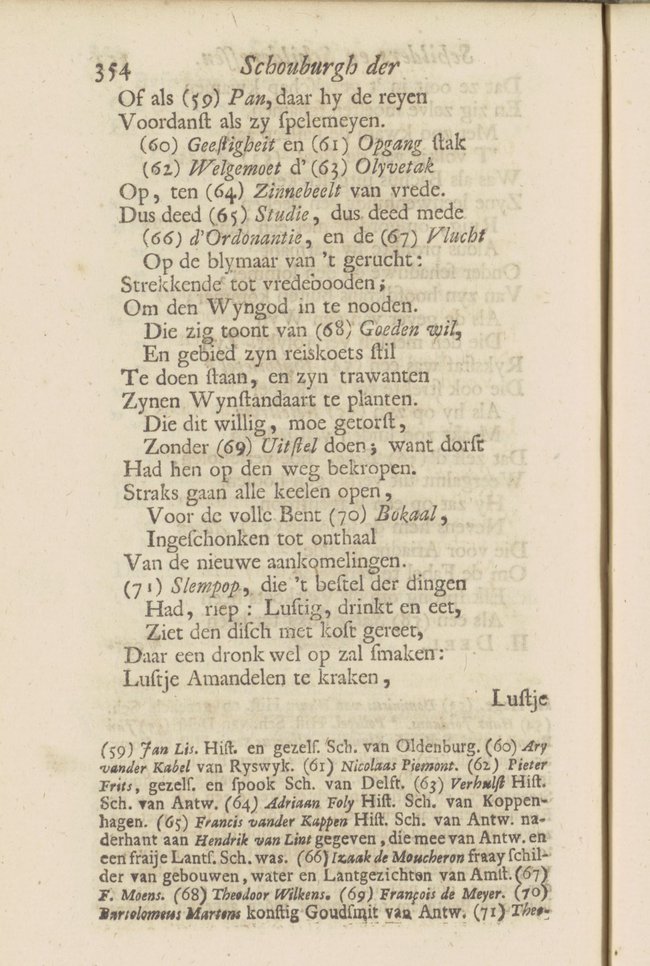
Page 355
Do you like sturgeon, or caviar,
Head cheese of all kinds,
Or also salted pretzels
Choice of many delicacies?
(72) Meleager then grabbed
The wild boar’s head. Upon my word
He spoke: This is certainly
The bait for a fresh beaker.
(73) Follower followed in the same path,
(74) Diligent served everyone something.
But (75) Sincere felt inebriated
(After the bent beaker had been drunk)
Crawled into a corner.
(76) Brave at once called, hang on,
Let us sooner smoke a pipe
Already smoking with (77) Leander.
Forthright joined in, increasing the number,
Who lack brains more than speech,
Wish to argue like philosophers,
And learn hidden things:
But himself is lost where he stands,
In the maze of all his talk.
Wine transforms the human spirits,
--------
landscape painter. Hendrick Mommers from Haarlem. (72) Jan Baptist Brueghel. (73) The name of this painter is not known to us, though we have come across the verse below along with his Bent name.
You who are greeted as brother of us all,
Now follow the bent’s customs in all that you do;
Thus our brotherhood will aways celebrate you:
And call you a follower of the law of the Roman bent.
Thus your name and fame will alway remain blameless,
Provided you are follower, and always will remain.
74) See 19. (75) Arendt Samuëlsz. Teerling from Alkmaar. (76) Franz Werner von Tamm, handsome flower painter. 77) Christian Reder, battle painter.
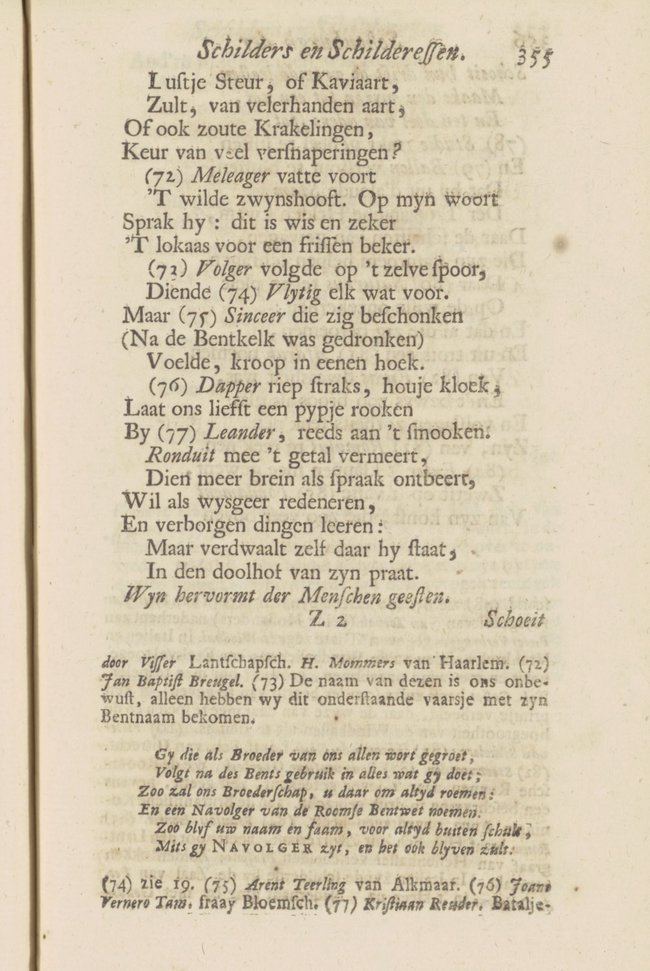
Page 356
Shods their desire on strange lasts,
Turns the wise man into a fool,
And target of everybody’s ridicule.
(78) Study becomes totally confused,
And (79) Balloon dares to brag,
That he came from an ancient Family
Of Trojan heroes,
As mentioned by documents
Which help support his family renown.
Which (80) Saturn controverts
With the certain uncertainty:
And that all who pride themselves
And out of pride to claim a (81) Descent
From (82) Aeneas is folly,
And the proof as fragile as glass:
And are signs of complete folly
To count back to (83) Romulus
(84) Magpie, also used to how things go
Roams on the firm (85) Foundation
Of his art, which was to be praised
--------
painter. (78) see 65. (79) This nickname was first given to Jean Petit, travel companion of Jan Toebak (both Dutchmen) and later to Pieter Verbruggen II. It means windbag. In Italy and France such windbags were attached to a donkey skin and filled with wind to play with. Jacques Callot has depicted it (to give an idea) in a print from which one can tell the manner of playing and the size of the windbags [1]. (80) Pieter van Sickeleers. (81) Jacob de Heusch, landscape painter from Utrecht. (82) Jacob van Steenvoorden. (83) Bonaventura van Overbeek, who drew the Roman ruins after life, etched them himself and published them in prints along with a description and dedicated to Brittanic Queen Anne [= Les Restes De L'Ancienne Rome]. (84) Francois Henrie. (85) Franz Ludwig Raufft, commendable history painting from Switzerland, painted various blazons and ceiling pieces for the Landgrave of Hessen-Kassel. While in Italy he made a small copy of the room of Pietro da Cortona. Later he went to live with Sun Flower [= Christian Berentz]
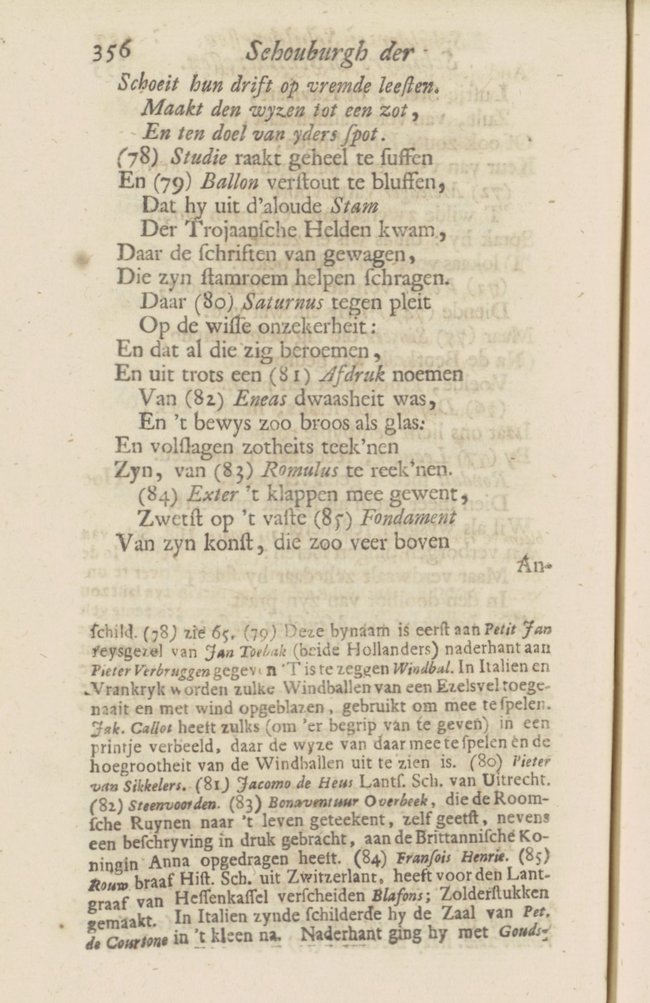

1
after Jacques Callot
View of the gardens at the ducal palace in Nancy, 1625
Amsterdam, Rijksmuseum, inv./cat.nr. RP-P-1949-517
Page 357
Far above that of others,
As the (86) Bird Phoenix with
Other birds. Goodheart free
Of this rambling of fools,
(no one thought of leaving)
Had his 87) Speculation about this.
(88) Guzzler was in agreement
Took no notice of all this drivel,
But stood tall like a (89) Golden Ass
And jaunty about his strength,
With the cup ever in his hand.
While (90) Hector stood boasting,
And summing up his acts,
Of his dart as (91) Cupid,
Where he was as dry as straw.
Change mentions the changes
Of time, and the fate of things:
--------
in Hamburg. (86) De Winter, history painter from Antwerp. (87) Johan Teyler. (88) see 71. (89) A German. In the bent they had baptized him as donkey, but dissatisfied with this he said: that he would not dare to return to his country with such a nickname. He presented the bentvogels with some money for drinks provided that they would give him another name. They accepted this and out of foolishness dubbed him the Golden Ass. (90) Bartholomeus Appelman. (91) I do not know the name of this artist. Cornelis van Ryssen, being in Rome, has (so it appears to me) helped initiate him and made this verse about that:
In all that lives there love is always needed,
By love the universe exists, by love all things live,
Not only on earth, but even with the gods,
Yes, if love were not practiced, the world would perish.
We who praise our Roman bent as perfect,
And thought that love was lacking in our bent,
We here name you with the honorary name of our little love god,
Otherwise known as Cupid, known to small or large.
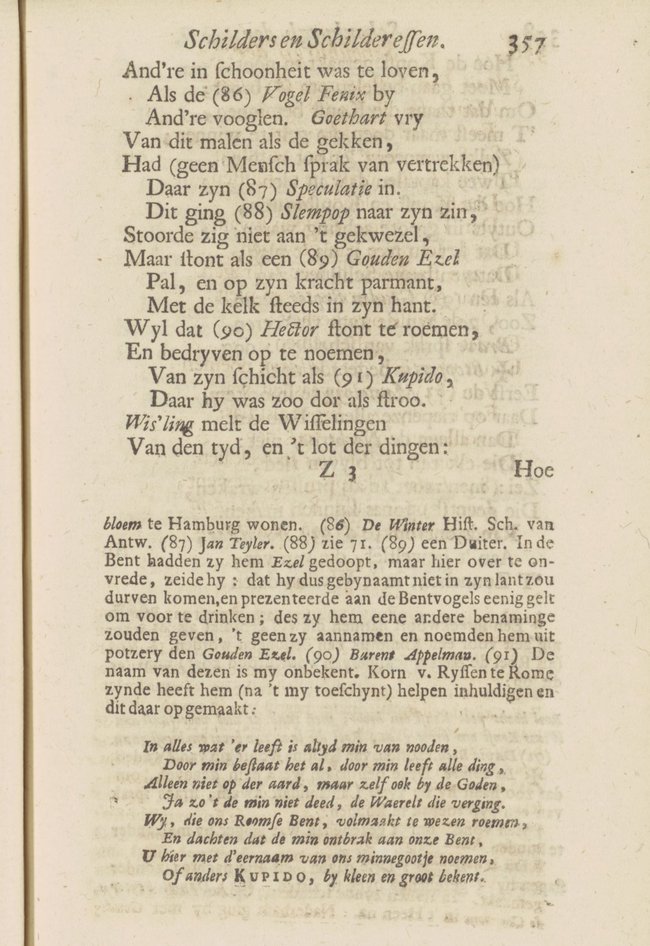
Page 358
How art is getting into trouble
Has to go begging for (*) bread
Because most now court that art
Mainly to make money;
Such who when they in every way,
See two capitals in it.
How art and artists,
Were highly esteemed in olden days:
Which we are now no longer in the habit;
When they saw commendable painters
Honoured like a (92) Golden Sceptre
Thus, thus chance may alter.
Brave spoke of parting: but
(‡) Little Stuffer still desired
First to smoke the (†) Mantle pipe
Then all called out: smoke.
Except for the Night raven:
Who urged everyone to stay,
Saying: that one should dismiss as non-entities
Who can’t pull off a triple (*) all-nighter
(93) Evening Star already lit up,
In the firmament, who from afar,
Saw the sunlight decline in the West
--------
* A proverb which is often used when there is little money to be got for an art work. Jan Vos (as Roel the baker bought paintings for bread) invented this:
Roel bought much art for bread; one does not obtain it otherwise. Whose art goes for bread, Roel has his bread go for art.(92) David Beck, court painter of Queen Christina of Sweden.
‡ Latombe [= Abraham Latombe]. This bent name was given to him because as soon as he had joined his countrymen, he at once spoke about stuffing a pipe.
† A ruse intended to keep the company together a little longer.
* That is to say, to hand out with company for three days and three nights without sleep. (93) Daniel Seiter,
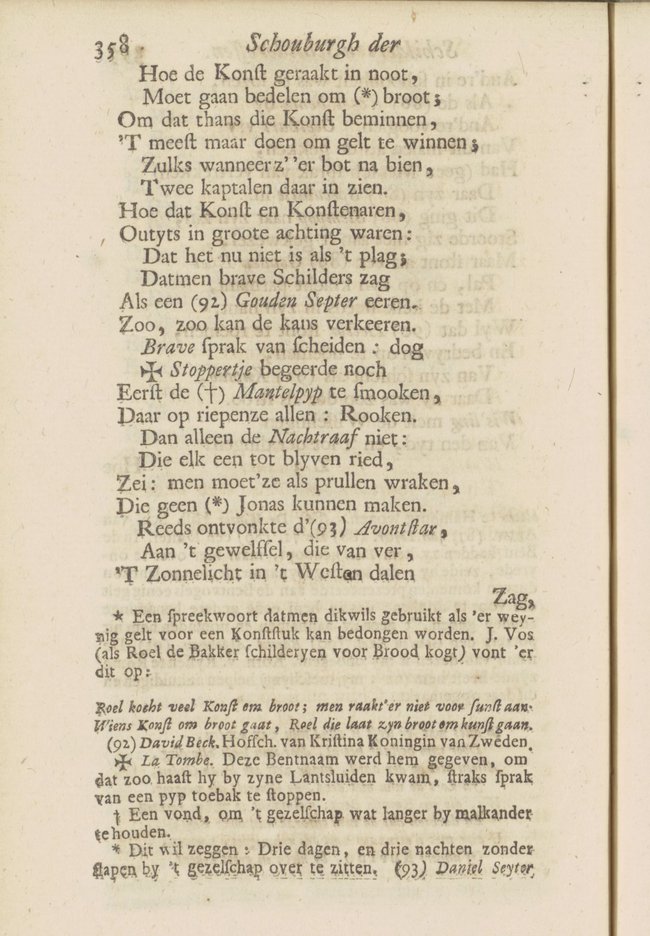
Page 359
With shrunken rays;
To end its circulation.
Everyone could, now heading for separation,
Clapper like the (94) Parrots,
Or chatter like market physicians.
At last this made Rot leave.
Guzzle Down, who still saw drink standing,
Opened his throat, and his lips,
And let the rest slip down,
As if he poured it through a Funnel;
But struck by this blow
He had to let his (95) Corpus sink
Down to the ground. Sensuality went limping,
The ailment gave him pain
In his heel and large toe.
He who licks Honey must suffer
The stings of the diligent bees.
Luxury is not always lasting
The saying goes: after the sweet comes the sour.
(96) Mixer makes strange turns,
Loose circles and glides.
(97) Diligence sometimes when going
Stays standing like a wooden Marionet
Stiff and motionless without speaking,
No matter what each may pray or preach:
Or like a (98) Pyramid
Dedicated to graves.
This one snuck away like a shade.
The other creeping like a (99) Turtle.
Others sideways like a (1) Crab
--------
history painter from Vienna. (94) Marcellis Librechts. (95) See 21. (96) Maurits Bibe from Den Bosch. (97) Jacob van Staverden, flower and fruit painter from Amersfoort. (98) Albert van Spiers. (99) Francoys Dancx. (1) Jan Asselijn,
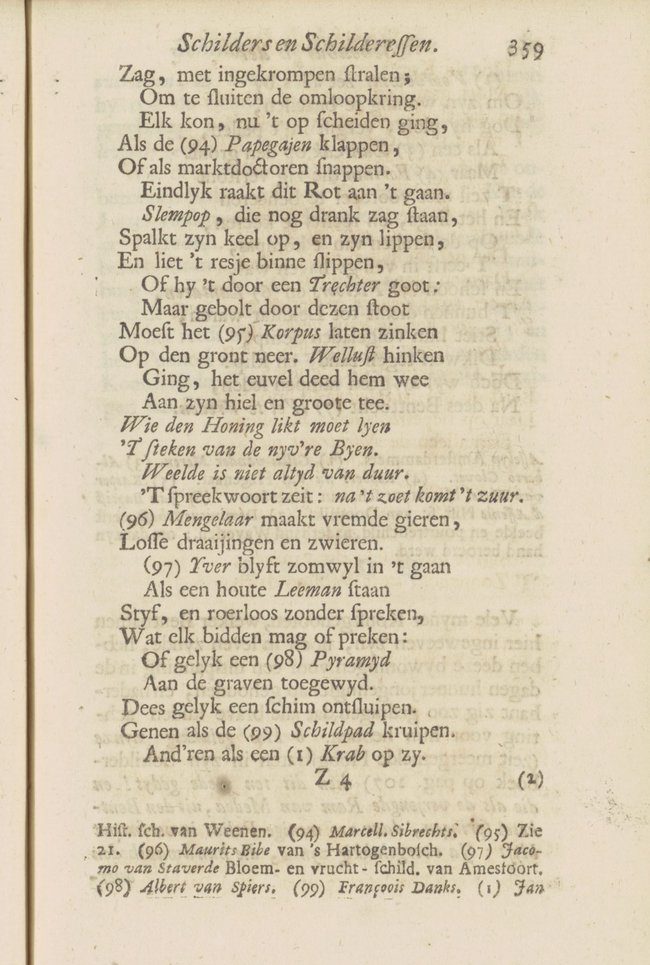
Page 360
(2) Before the Wind raises all sails
To sail to his dwelling.
But he thuds, mistaken in plumbing,
Like a (3) Sandbag on the ground
But (4) Fortune who understood
How to manage the sails to advantage
And how to turn left and right,
To the points of the compass,
Was the first in safe haven.
And though (5) Piktoors and (6) Lantern,
Were of service as lodestar,
Their fully loaded ship,
Often struck sand, and reef;
But because they did not suffer any disasters
After this bent Journey (7) Well Satisfied
--------
Amsterdammer. (2) Egidius van der Meeren. (3) Albertus Clouwet. (4) Robbert Duval from The Hague. (5) Caspar van Wittel, miniature painter from Amersfoort. (6) Jean Baptiste Assenede, history painter from Doornik. (7) Dominicus Schaft, first figure and portrait painter, later painter of fans, because his hand became paralized.
--------
Many of my fellow artists whose bent names are here interspersed, still being alive, have taken their attendance for a diversion in the days of their youth and later behaved in such a way that all commendable people hold them in esteem. Oh, How fortunate are those (says often mentioned Hoogstraten on page 207 of his Book on painting) who profit from this and who as Medea’s rejuvenated ram spring out of the bent kettle in which so many remain smothered. Yes, more than happy are those who survive their folly
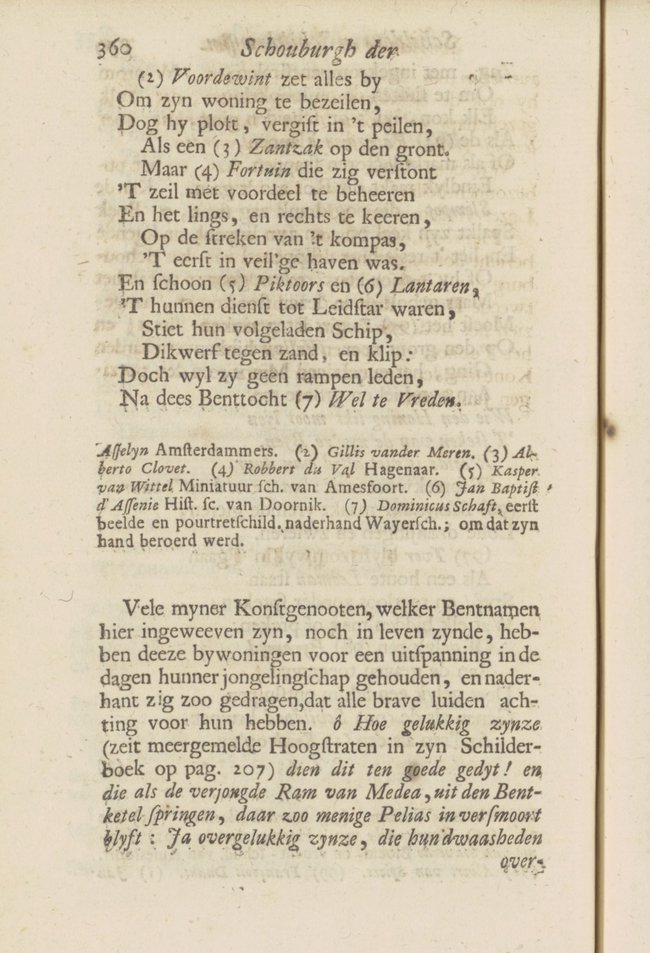
Page 361
and look back on their foolishness. And that is why he warns youthful painters that such company is fraught with danger, especially for living spirits who are easily tempted.
Who this just-mentioned Pelias was, and the ill-considered behaviour of his daughters etc. the reader can find in the 3rd chapter of the 7th book of the Metamorphoses by Ovid. We end with the announcement that the third volume of the Theatre of Painters stands to appear in much shorter time than the second volume, seeing that it has already been begun, and the stage will open with the renowned painters Frans van Mieris and the farcical Jan Steen.
END.
